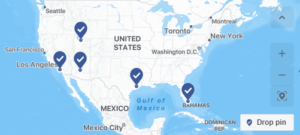Location-based advertising is an effective way for marketers to reach their target audience with relevant and personalized ads based on their location. Three common approaches to location-based advertising are Geolocation, Geofencing, and Geoframing. While these terms are sometimes used interchangeably, they

Illustration of putting a radius around an area to target devices coming into the zone and serving them an ad.
refer to distinct strategies for using location data to target advertising. By understanding these differences, marketers can choose the most effective strategy for their specific campaign and deliver more relevant and personalized ads to their target audience.
What are the differences?
Geolocation: The process of determining a user’s physical location based on their IP address or GPS coordinates. This technique is often used to serve location-specific content to users, such as local news or weather updates. In targeted advertising, geolocation data can be used to deliver ads to users based on their current location. For example, a car dealership may use geolocation to serve ads to users who are within a certain distance of their showroom.
Geofencing: A location-based advertising technique that uses GPS or RFID technology to create a virtual boundary, or “fence,” around a specific location. When a user enters this virtual boundary, they are served targeted ads on their mobile device. Geofencing is typically used for events, retail stores, or specific geographic areas, such as a city or neighborhood. For example, a coffee chain may use geofencing to target customers within a 2-mile radius of their store with a special offer for a free drink. Or a larger designated market areas (DMAs) or Zip Codes.
Geoframing: A newer and more advanced form of geofencing that involves capturing historical location data from users’ mobile devices. This technique allows marketers to target users who have previously been in a specific location, such as a competitor’s store, and deliver ads to them after they have left that location. “Geoframing providers utilize mobile service carrier and device ID data to create pools of users for custom audience targeting and Device ID Retargeting (in the U.S.)” For example, a fast-food chain could use geoframing to target users who have recently visited a competitor’s restaurant with an ad for their own menu items.
5 Best Practices for Location-Based Digital Advertising
Across all the geo-based tactics the following are things to consider on when it’s appropriate to use the tactic withing a more holistic media plan.
- Consider the user’s stage in the customer journey when delivering location-based ads, such as targeting users who are near the end of the funnel with a call to action to visit your store.

Facebook geolocation example of targeting specific DMAs with ads.
- Use location data in combination with other targeting criteria, such as demographics and interests, to create a more complete user profile.
- Use personalized messaging and offers to encourage engagement from users who enter the geofenced area.
- Monitor performance and adjust your geography as needed based on user behavior and engagement rates.
- Be sensitive to user privacy concerns by offering transparency about data collection and opt-out options.
In general, it’s important to be respectful of user privacy and to focus on delivering relevant and personalized content that adds value to the user’s experience. By following these best practices, marketers can use location-based advertising techniques to build stronger connections with their target audience and drive better results for their campaigns.
Additional Considerations
While Geofencing, Geoframing, and Geolocation are powerful location-based advertising techniques, there are also some potential issues that marketers should be aware of. Here are some common issues with these tactics:
- Accuracy: The accuracy of location data can vary depending on the technology used and environmental factors. For example, GPS signals can be disrupted by buildings or trees, which can result in inaccuracies in Geofencing and Geoframing. In addition, IP addresses can be imprecise and may not always reflect the user’s physical location, which can impact the accuracy of Geolocation.
- Privacy & Compliance: Location data can be sensitive information, and users may be uncomfortable with the idea of being tracked or having their location shared with third-party advertisers. Marketers need to be transparent about data collection practices and offer users the ability to opt out of location tracking. Location-based advertising is subject to regulations and guidelines, such as GDPR and CCPA. Marketers need to ensure that they are following these regulations and have processes in place to handle user data and requests for opt-out.
- Ad fatigue: Receiving too many ads in a short period of time can lead to ad fatigue and reduced engagement. Marketers need to be strategic in their delivery of location-based ads and ensure that they are relevant and personalized to the user’s interests.
- Costs: Sometimes costs can increase if the targeting is too narrow for the intended target. May require adjusting any of the additional demographic and interests to cast a wider net. Or adjustments in the parameters of how tight the targeting is. Also, use this tactic in conjunction with broader awareness and traffic driving tactics.
Using Geolocation, Geofencing, and Geoframing in a Cookieless Environment
Many location-based advertising techniques traditionally relied on cookies to track and target users. However, with the ongoing shift towards a cookieless environment, also known as the deprecation of cookies in digital advertising, marketers are exploring new ways to use these approaches without relying on cookies.
These tactics can still be used by relying on IP addresses or device IDs. However, this approach can be less accurate than cookies, as it may not always reflect the user’s physical location. Additionally, marketers may need to rely on other forms of targeting, such as contextual or demographic targeting, to ensure that their ads are reaching the right audience. Additionally, some third-party platforms may offer alternative methods of device identification that can be used for Geofencing without relying on cookies.
Geoframing can be more challenging to implement, as it relies on tracking users’ location history over time. One potential solution is to use contextual targeting based on the content that users are consuming on their devices. For example, if a user is reading an article about a specific location, a marketer could serve them a relevant ad based on that content. Additionally, some mobile devices may offer alternative methods of location tracking, such as Bluetooth beacons or Wi-Fi triangulation, which can be used for Geoframing without relying on cookies.
Final Thoughts
Hopefully this information will help you when talking to your agency or advertising partners about leveraging location-based targeting tactics. Using geolocation to narrow your targeting to areas your brand serves, or wanting a competitive Conquesting tactic or as a way to penetrate a new market is a powerful tool. Sometimes we see the use of overly narrow geofencing and geoframing used as the whole strategy for digital marketing by both agencies and brands instead of a tactic as part of the overall full-funnel marketing strategy. It’s important to generate enough awareness, build your organization’s first-party data and use these more narrow tactics for specific offers and competitive blunting tactics with personalized and/or relevant ads based on those locations.
Case Study
Example of RocketSauce Media Labs using geofencing as part of a larger Paid, Earned, Shared and Owned (PESO) client. Johns Hopkins completes COVID-19 clinical trial recruitment with the help of PESO strategy
Contact us for additional information and case studies on how we use geofencing tactics for our clients.


